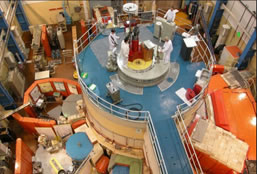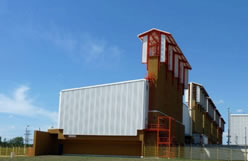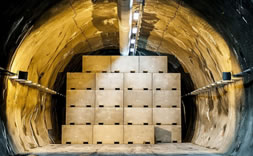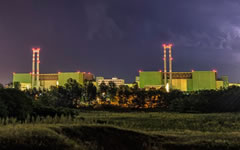
Milestones of nuclear energy development in Hungary during the past 40 years
1974: start of construction of units 1 and 2 of Paks NPP (VVER-440)

Fig.1. Constructions works at the Paks NPP
1975: establishment of the Atomic Energy Research Institute
1976: start of operation of Radioactive Waste Treatment and Disposal Facility at Püspökszilágy
1979: start of construction of units 3 and 4 of Paks NPP (VVER-440).
1980: acceptance of first atomic law
1982: connection to grid of unit 1 of Paks NPP
1984: connection to grid of unit 2 of Paks NPP
1986: connection to grid of unit 3 of Paks NPP
1987: connection to grid of unit 4 of Paks NPP
1987: start of operation of simulator centre at the Paks NPP
1991: establishment of the Hungarian Atomic Energy Authority
1991: formation of the Hungarian Nuclear Society
1993: completion of the reconstruction of the Budapest Research Reactor

Fig. 2. Budapest Research Reactor
-
1994: reassessment of the safety of Paks NPP in the framework of the AGNES project
-
1997: acceptance of second atomic law
-
1997: start of operation of Interim Spent Fuel Storage Facility

Fig. 3. Interim Spent Fuel Storage Facility

Fig. 4. National Radioactive Waste Repository
-
2012: approval of lifetime extension for unit 1 of Paks NPP
-
2014: decision on building two VVER-1200 units on the site of Paks NPP
-
2014: approval of lifetime extension for unit 2 of Paks NPP

Fig. 5. View of the Paks NPP
The first reactor at the Paks NPP was put into operation in 1982, the second in 1984, the following units in 1986 and 1987. The reconstruction of the research reactor at the Centre for Energy Research (CER) of the Hungarian Academy of Science was done in 2009 -- the HEU fuel elements have been replaced with LEU fuel rods, the HEU fuel elements were transported to Russia. The main topics for research and developments at the CER are:
-
Nuclear safety research,
-
New reactor systems,
-
Man-machine interface and applications,
-
Dosimetry, health physics, environmental analysis,
-
Nuclear safety analysis, safety and security issues,
-
Radiation chemistry and its applications,
-
Nuclear reactions and methods for analysis,
-
Surface chemistry and catalysis
The training reactor at the Institute of Nuclear Techniques (INT) of the Budapest University of Technology and Economics (BME) has been in operation since 1971. INT holds lectures and laboratories for the BSc, MSc and Ph.D. students graduated in the field of "Nuclear Energy", "Nuclear Techniques" "Medical Physics" and "Nuclear Energy" The institute organises regularly the postgraduate continuing education program "Reactor techniques", organises and participates in the international "Eugene Wigner Course for Reactor Physics Experiments" ENEN exchange course (in English).
The medical application of nuclear technology has become widespread in Hungary: X-ray and isotope diagnostics, monitoring examinations, radiotherapy by accelerators and sealed radioactive sources, and isotope diagnostics and therapy by radioactively labeled compounds. For human and environmental safety purposes the Health Environmental Radiological Monitoring Network and Authority Nuclear Safety Monitoring Network were established. The data of the national monitoring networks is collected and processed by the National Radiological Monitoring Network.
The challenges we faced in the past are related to several topics. AGNES (Advanced General Safety and New Evaluation of Safety) project was started in 1991. The goal of the project was to evaluate to what extent Paks NPP satisfied the current international safety expectations and to help in determining the priorities for safety enhancement and upgrading measures. The project was completed in 1994. In this framework, the seismic resistance of the NPP was substantially improved. Also, a Central Nuclear Financial Fund was established as of the 1st of January 1998 by the Act on Atomic Energy and the executive orders thereof, with the purpose of financing the disposal of radioactive wastes, the interim storage, and final disposal of spent nuclear fuels and the decommissioning and dismantling of nuclear facilities.
Three of the most important technical tasks for the coming years: extension of a new disposal facility for the low- and intermediate-level wastes (L/ILW), and also of the existing Interim Spent Fuel Storage (ISFS), and the selection of a site for the long-lived high level waste (HLW) repository.
Also, we have to consider the power uprate of NPP Paks done in the period 2006-2009: the original 440MW capacity was increased to 500 MW for each of the 4 reactors. The plant’s lifetime extension program was started in 2007. The lifetime extension of Unit 1 was approved in 2012, of Unit 2 in 2013. The application for Unit 3 was submitted by the end of last year, and for Unit 4 it will be submitted by the end of this year.
Furthermore, the Teller project was initiated in 2007 aiming at the preparation for the construction of 2 more reactor blocks at the Paks NPP site. The project now is running under name of Lévai-project. The consequences of the 2003 event connected with the overheating of some used fuel assemblies during a cleaning process -- assessed level 3 on the IAEA INES scale -- were successfully eliminated.
Future plans:
Hungary is committed to using nuclear energy for electricity production in the future. We are in the licensing phase of two new build VVER-1200 design nuclear power reactors. Hungary is looking to maintain the share of nuclear power in the energy mix.
The European Commission initiated two investigations on the issue of Paks II new build project: on procurement and state aid matters. To answer the ECs remarks properly and to get a green signal for the new NPP construction from the EC is the No. 1 challenge for the nearest future. The construction of the new NPP (two Russian reactor blocks 1200 MW each) is the largest construction work that has been performed in Hungary in recent decades. To build the plant timely is a key factor of the economy of the plant due to the huge investment costs (discount rate effect). The fate of the new build project is crucial for the future of the nuclear industry in Hungary.
If, and when, renewables become economically competitive, nuclear will have a hard time staying viable, both from an economic and political standpoint. However, this scenario seems – at this time – to be far off in the future.
We are also looking into a solution of the disposal of spent fuel which should be found as soon as possible to demonstrate to the public that the nuclear industry is capable of dealing with the radiactive waste management issue safely and economically. As an alternative, the transport of the fuel back to Russia for reprocessing should be considered. Concerning the project for a National Radioactive Waste Repository, the main task for the future is to provide disposal capacity for the low and intermediate level waste generated at Paks NPP. On the basis of the optimized disposal concept, a reinforced concrete vault shall be constructed in the 2nd disposal chamber.
The main challenge in the field of radioactive waste management is to implement the deep geological repository, which serves as a final solution for the disposal of the high level and/or long-lived wastes. Hungary is in the very beginning of this project. A surface based geological investigation is ongoing in the Boda Claystone Formation aiming to narrow down the investigation area and in the mid-term (till 2030) to designate the location of the Underground Research Laboratory.
Currently the spent fuel is safely stored in the Interim Spent Fuel Storage Facility, which is a Modular Vault Dry Storage system. This facility can be extended modularly in parallel with the spent fuel generation at Paks NPP. Beside the regular expansion, the originally planned 50-year lifetime of the facility has to be prolonged with at least an additional 30 years. A significant research and development program has to be carried out in the mid-term to justify the lifetime extension.
|

